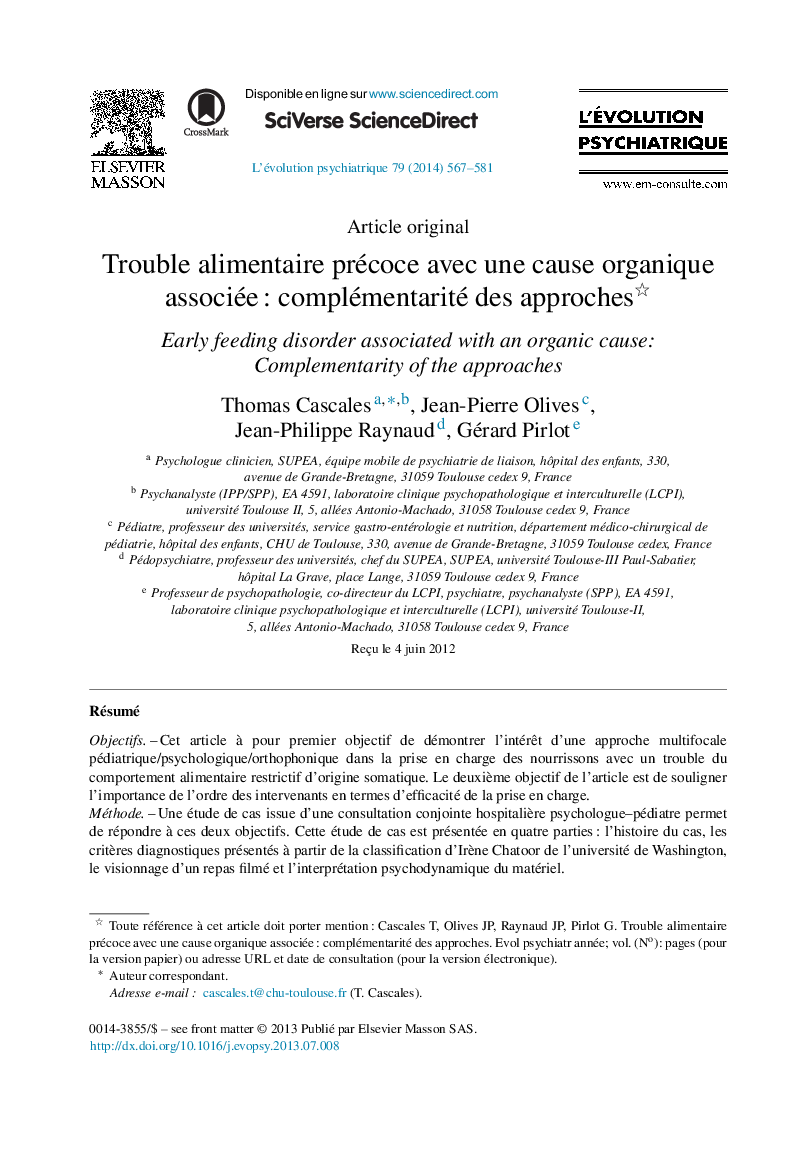| کد مقاله | کد نشریه | سال انتشار | مقاله انگلیسی | نسخه تمام متن |
|---|---|---|---|---|
| 908491 | 917180 | 2014 | 15 صفحه PDF | دانلود رایگان |

RésuméObjectifsCet article à pour premier objectif de démontrer l’intérêt d’une approche multifocale pédiatrique/psychologique/orthophonique dans la prise en charge des nourrissons avec un trouble du comportement alimentaire restrictif d’origine somatique. Le deuxième objectif de l’article est de souligner l’importance de l’ordre des intervenants en termes d’efficacité de la prise en charge.MéthodeUne étude de cas issue d’une consultation conjointe hospitalière psychologue–pédiatre permet de répondre à ces deux objectifs. Cette étude de cas est présentée en quatre parties : l’histoire du cas, les critères diagnostiques présentés à partir de la classification d’Irène Chatoor de l’université de Washington, le visionnage d’un repas filmé et l’interprétation psychodynamique du matériel.RésultatsDeux grands axes thérapeutiques doivent être abordés avec les parents. Un premier axe est consacré aux angoisses chez le nourrisson liées à la nourriture et à ses conditions d’absorptions (climats du repas, ambiance), mais également à la qualité des interactions parents–nourrisson durant l’alimentation. Un second axe, dit fonctionnel, correspond aux vécus éprouvant du nourrisson face aux expériences fonctionnelles d’absorption et de déglutition.DiscussionsCes deux axes thérapeutiques sont donc complémentaires, mais ne doivent pas être pris en charge de façon concomitante. Il est nécessaire pour valoriser leur articulation que les deux prises en charge se succèdent dans un ordre précis. La prise en charge psychothérapeutique doit être première et la prise en charge en orthophonie secondaire. Malgré tout, chaque situation doit être réfléchie au cas par cas.ConclusionsDans le cas d’un trouble fonctionnel de la déglutition lié à une pathologie somatique, les empreintes corporo-psychiques laissées par les expériences traumatiques liées à l’alimentation et les maladresses interactives qui en découlent doivent être traitées par le biais d’une réappropriation harmonieuse de la fonction abimée à travers des expériences positives in vivo auxquelles les parents doivent participer. Pour cela le premier axe psychothérapeutique doit être complété par un axe rééducatif centré sur les fonctions d’alimentation et de déglutition.
ObjectiveFirst, this article aims at demonstrating the value of a multifocal approach, i.e. combining paediatric, psychological and speech therapy, in the treatment of infants with a disorder of restrictive eating behaviour of somatic origin. Second, this article seeks to emphasize the importance of the therapists’ sequence in the care's efficiency.MethodA case study based on a joint psychologist–paediatrician hospital consultation meets these two objectives. The case study is presented in four parts: a case history, the diagnostic criteria as presented on the basis of the classification of Irene Chatoor from the University of Washington, the watching of a videotaped meal and the psychodynamic interpretation of the material.ResultsTwo major therapeutic axes have to be discussed with parents. The first axis is devoted to the infant's anxieties linked to the food and its absorption conditions (meal's climate, atmosphere) as well as to the parents’/infant's interactions during feeding time. The second axis, known as functional, corresponds to the stressful experiences of the infant faced with the functional experiments of absorption and swallowing.DiscussionThese two therapeutic axes are complementary areas. However, they should not be handled concomitantly. Indeed, it is necessary, to enhance their articulation, that one step follows the other in a specific order. The psychotherapeutic care has to come first, followed by the speech therapy. Still, each situation must be dealt with on a case by case basis.ConclusionsIn the case of a functional swallowing disorder due to a somatic pathology, the corporo-psychic imprints left by traumatic experiences related to food, as well as by the interactive awkwardness arising therefrom, should be treated through positive in vivo experiences involving the parents, and through a harmonious reappropriation of the damaged function. For this, the first psychotherapeutic axis must be completed by a rehabilitative axis, centred on the feeding functions of absorption and swallowing.
Journal: L'Évolution Psychiatrique - Volume 79, Issue 3, July–September 2014, Pages 567–581